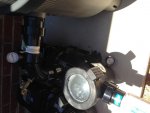I don't leave my lights on all the time, I am very energy conscious. Have one of the most energy efficient houses in Frisco TX. Frisco now uses most of the ideas that we originally put in the house, I don't take credit for this, the people that enforce the building codes in Frisco are awesome.
However, when I look at the documentation from Jandy, they show that at 47 GPM they are using 300 watts at 1730 RPM. If I was publishing this information I would use a number higher than the actual number to protect myself from a fraudulent lawsuit. Therefore, I believe that our pump using 240 watts (checked it and found this to be the number) is accurate. In addition, we use 2.5" plumbing everywhere and put in a filter that is twice the size of what the pool builder proposed so our head is actually quite low (clean indicator on the filter is well below the clean line after two months of pool use and both head pressure gauges are very low).
As to the flow rate, you bring up a good point. A&A will be out to install a flow meter within the next couple of weeks so that I can more accurately know what the pumps are pushing.
I like the idea of running the pool slower and longer. I too live in the Dallas area, in Frisco. During the winter I might slow it down but right now there is all kinds of trash in the air from the cottonwood trees.
I check the FC every day as well as the CYA, Alkalinity, Total Chlorine, hardness, etc.
pooldv, how is solar working for you? Our setup allows us to do that but I'm a bit concerned about our view of the southern sky. It's good right now but as our trees grow in the front (which faces south) we'll start to lose coverage in about 10 years.
We also took similar steps to what you are doing, put in everything we need for a heat pump, at 84 the pool is still to cold for my wife.


